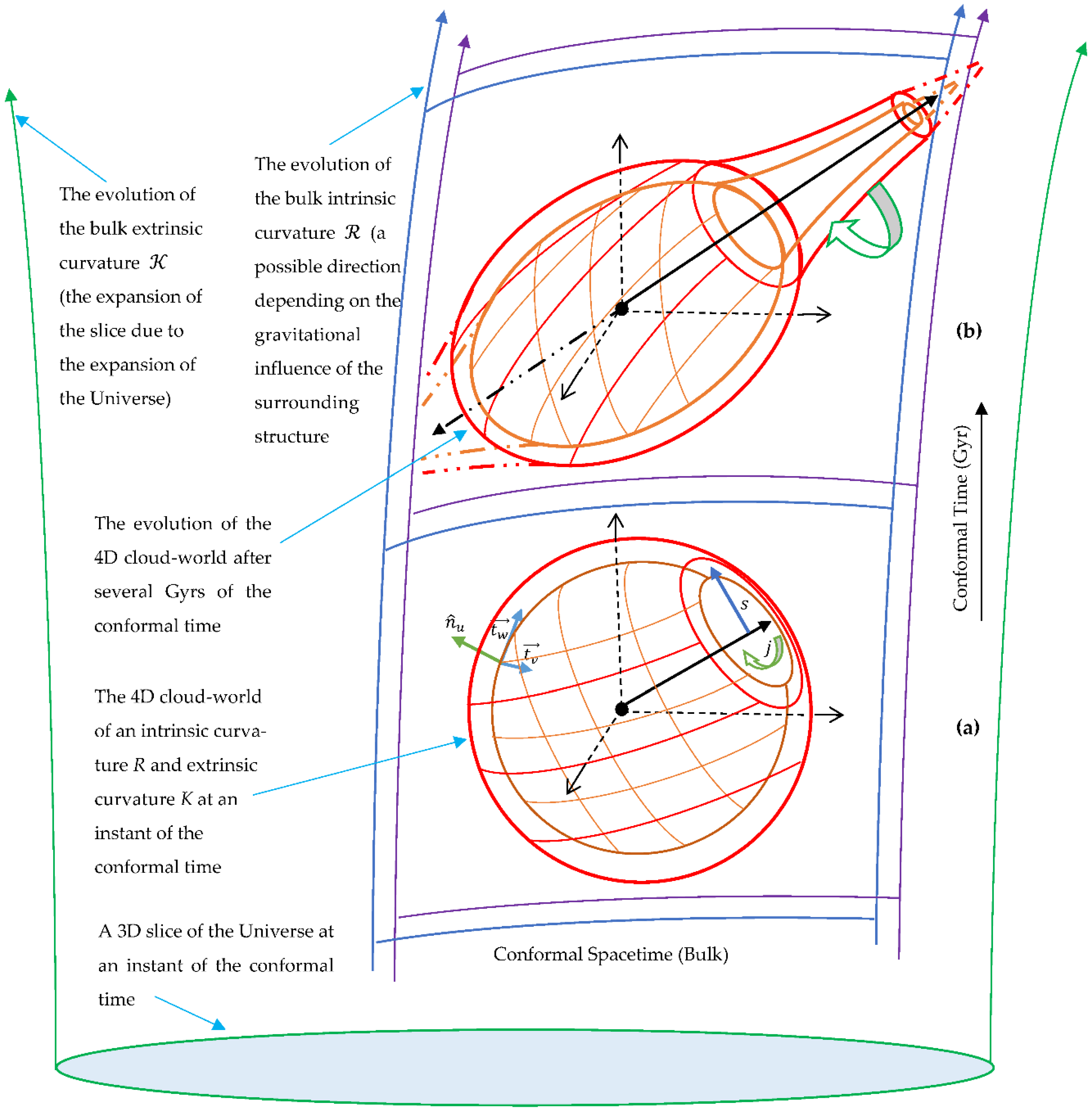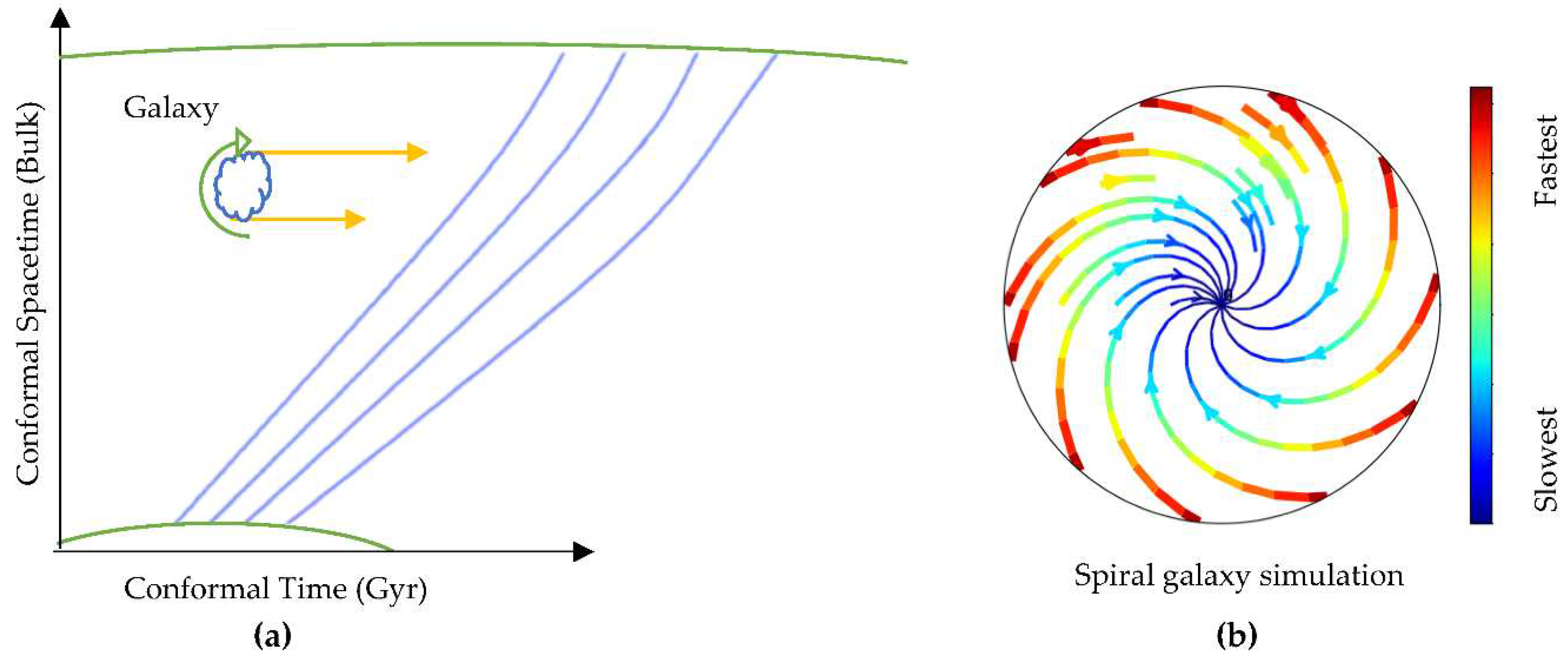2. Interaction Field Equations
The PL18 release has preferred a positively curved early Universe, that is, is a sign of a primordial background curvature or a curved bulk. To incorporate the bulk curvature and its evolution over the conformal time, a modulus of spacetime deformation,
in terms of energy density, is introduced based on the theory of elasticity [
8]. The modulus can be expressed in terms of the resistance of the bulk to the localized curvature induced by celestial objects by using Einstein field equations or in terms of the field strength of the bulk by using the Lagrangian formulation of the energy density existing in the bulk as a manifestation of the vacuum energy density as follows
where
is the field strength tensor of the bulk and
is vacuum permeability. By incorporating the bulk influence, the Einstein–Hilbert action can be extended to
where
is Ricci scalar curvature representing a localized
curvature induced in the bulk by a celestial object that is regarded as a 4D relativistic cloud-world of metric
and Lagrangian density
.
is the scalar curvature of the 4D bulk of metric
whereas
is the bulk’s Lagrangian density as an indication of its internal stresses and momenta reflecting its curvature. A dual-action concerning the conservation of energy on global (bulk) and local (cloud-world) scales can be introduced as
By applying the principle of stationary action in [
9] yields
The interaction field equations can be interpreted as indicating that the cloud-world’s induced curvature over the bulk’s existing curvature equals the ratio of the cloud-world’s imposed energy density and its flux to the bulk’s vacuum energy density and its flux through the expanding/contracting Universe. The equations can describe the interaction of a 4D relativistic cloud-world of intrinsic
and extrinsic
curvatures with a stress-energy
and the 4D bulk of intrinsic
and extrinsic
curvatures with a stress-energy
(as visualized in Figure 2). By utilizing
Equation (1) that states
, the field equations can
be simplified to
where
or can be
simplified to
is the conformally transformed metric tensor counting for the contributions of the cloud-world metric,
in addition to the contribution from intrinsic and extrinsic curvatures of the bulk, whereas Einstein spaces are a subclass of conformal spaces [
10]. The evolution in
reflects the field strength of the bulk and depends on the bulk or background curvature.
3. Galaxy Formation and Relativistic Jet Generation
The entire contribution comes from the boundary term when calculating the black hole entropy using the semiclassical approach [
11,
12]. By applying this concept and re-arranging the field equations for this setting as
The field
equations can describe the interaction between a 4D
relativistic cloud-world of intrinsic
and extrinsic
curvatures with a stress-energy
and the 4D bulk of intrinsic
and extrinsic
curvatures with a stress-energy
. From Equation (6), the field equations yield
where
and
is the conformal bulk metric, which can be
expressed as proportional to cloud-world metric
as
by utilizing
, the conformal transformation function. The conformally transformed metric
can be expressed as
where
and
are functions of the cloud-world
radius
,
is a dimensionless conformal scale factor. By performing the coordinate transformation as follows
where the conformal
function
is a function of the bulk radius of curvature
and it can be influenced by the cloud-world radius.
The Christoffel symbols of this metric are
where the sign
is a total derivative of the function. The Ricci tensor components are
By substituting Ricci tensor components to Equation (7) gives
Equation (16) yields
where
for the conformal metric by considering the bulk curvature.
By applying the weak-field limit:
, as follows
where
is the Newtonian gravitational potential. By integrating both sides
where
is the gravitational potential of the
cloud-world’s spherical mass and
that arises from the integration can be interpreted as the gravitational potential resulting from the bulk curvature, which can be expressed, using the same Newtonian analogue, in terms of the mass,
, of the early Universe plasma of preferred
positive curvature and the bulk curvature radius
as
. The metric should yield only the gravitational potential of the cloud-world when there is no bulk curvature
and (
; hence,
; consequently, the conformal function is
.
By performing the coordinate retransformation and combining Equations (17 - 19) yield
where the conformal function
relies on the gravitational potential of the bulk while its influence is inversely proportional to cloud-world potential. In the case of PI18’s preferred early Universe positive curvature, the gravitational potential of the bulk can be expressed in terms of the early Universe plasma of mass,
, and
denoting the radius of curvature of the bulk, where the bulk’s potential decreases with the Universe expansion and vanishes in the flat spacetime background (
. The minus sign of
reveals a spatial shrinking through evolving in the conformal time, which agrees with the vortex model that can occur due to high-speed spinning. By substituting Equation (20) to Equation (8), the conformally metric
is
This metric reduces to the Schwarzschild
metric in a flat background (
, where
is the background or bulk
curvature radius,
is Schwarzschild radius,
is early Universe gravitational radius and
is a dimensionless spatial scale factor. The denominator of the radial dimension can be interpreted as an intrinsic curvature term where the metric on the radial and two-sphere is warped by the bulk and cloud-world radii. The metric can be visualized through evolving in the conformal time by using Flamm's approach as follows
where
is a constant and
denotes less significant terms. By choosing an appropriate
,
Figure 1 shows the proper distances, and their corresponding proper areas are increasing as they are evolving in the conformal time while the radius decreases.
The increase in the proper distances and their corresponding proper areas as the radius decreases agree with the vortex model while the positive and negative solutions of Equation (22) indicate the evolution of the vortex in opposite directions, i.e., forming a dual vortex perpendicular on the galaxy plane. The 4D cloud-world of metric through its travel and spin in the conformal
space-time of the 4D bulk of metric .
The G2 cloud has only faced drag forces [
4,
5], where orbiting a vortex could explain these observations if its orbit is at a distance from the central event horizon. In addition, the observations of the superluminal motion in the x-ray jet of M87 [14] could be travelled through these two opposite traversable wormholes.
To evaluate the influence of the spinning and the curvature of the bulk on the core of the galaxy and the surrounding gas clouds (the spiral arms), a fluid simulation was performed based on Newtonian dynamics by using the Fluid Pressure and Flow software [
13]. In this simulation, the fluid was deemed to represent the spacetime continuum throughout incrementally flattening curvature paths representing conformal curvature evolution to analyze the external momenta exerted on objects flowing throughout the incrementally flattening curvatures. The momenta yielded by the fluid simulation were used to simulate a spiral galaxy as a forced vortex as shown in
Figure 3.
The simulation shows that the tangential speeds of the outer parts of the spiral galaxy are rotating faster in comparison with the rotational speeds of the inner parts, which resembles observations of galaxy rotation except the simulation used an ideal fluid.







